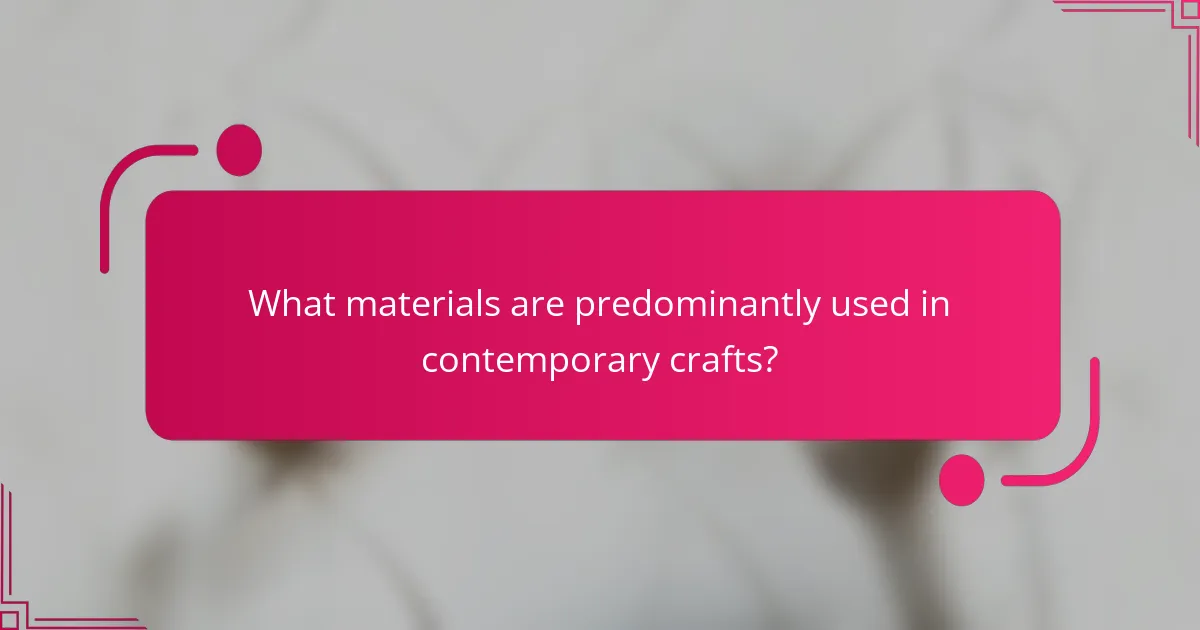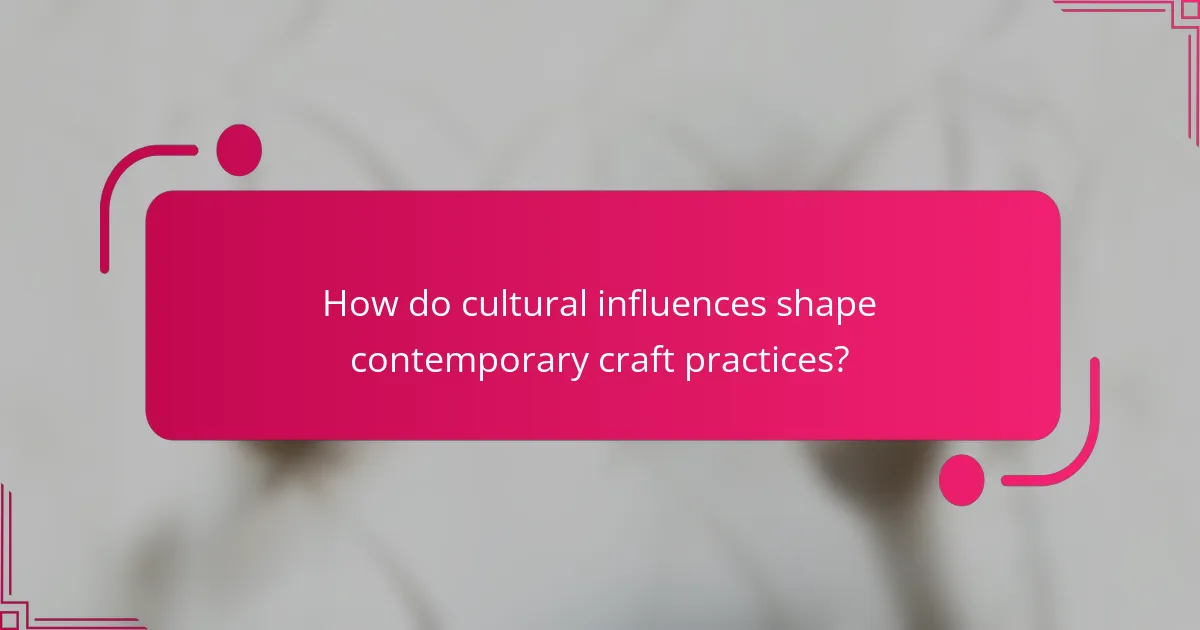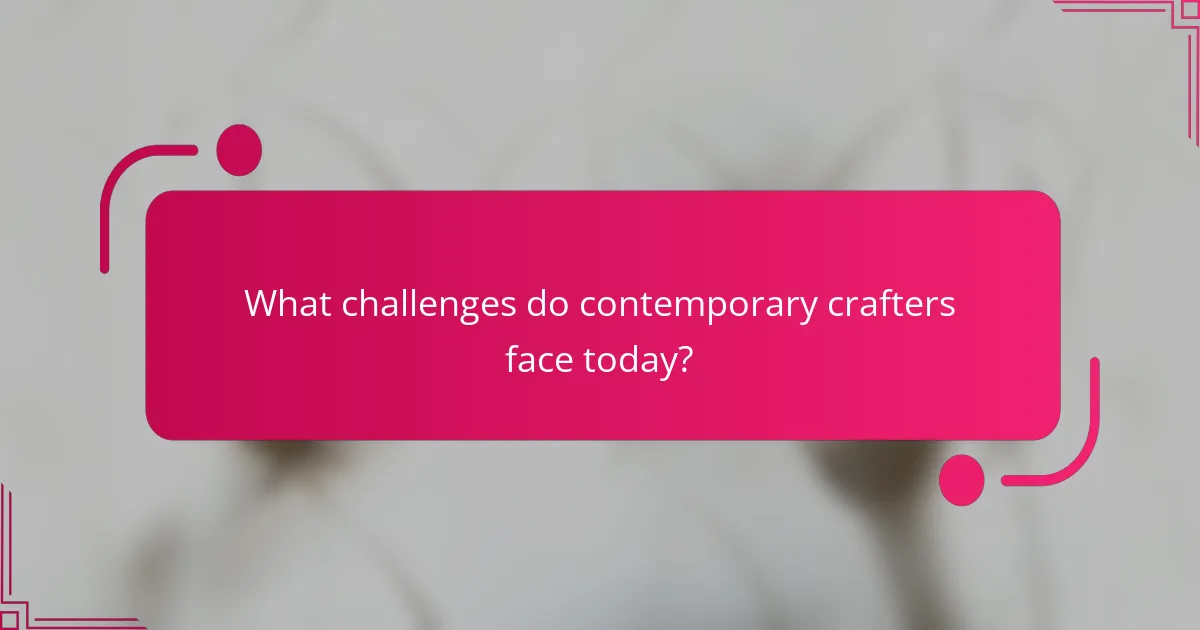Contemporary craft practices highlight the intersection of creativity, skill, and cultural significance. This article explores key techniques such as hand-building, weaving, and surface decoration. It examines diverse materials like clay, textiles, and wood, and their impact on craft. Additionally, it addresses the cultural influences shaping modern craftsmanship and the challenges faced by artisans today.

What are the key techniques in contemporary craft practices?
Contemporary craft practices utilise various techniques that emphasise creativity and skill. Key techniques include hand-building, weaving, and surface decoration.
Hand-building allows artisans to shape materials like clay without the use of a wheel, fostering unique forms. Weaving techniques incorporate diverse fibres, creating intricate patterns and textures. Surface decoration methods, such as glazing and painting, enhance aesthetic appeal and individuality.
These techniques are often combined with sustainable materials, reflecting a cultural significance that values craftsmanship and environmental consciousness. The integration of technology, like digital fabrication, further expands the possibilities in contemporary craft.
How do traditional techniques influence modern craft?
Traditional techniques significantly shape modern craft by integrating cultural heritage and innovative practices. These techniques provide a foundation for contemporary artisans, allowing them to blend historical methods with new materials and technologies. For example, weaving patterns from indigenous cultures influence modern textile designs, creating unique aesthetic values. Additionally, traditional pottery techniques inform contemporary ceramic practices, enhancing the functionality and artistry of new creations. This fusion of old and new not only preserves cultural significance but also inspires creativity in contemporary craft.
Which innovative methods are emerging in the craft community?
Innovative methods in the craft community include digital fabrication, sustainable materials, and collaborative workshops. Digital fabrication utilises technologies like 3D printing to create intricate designs. Sustainable materials focus on eco-friendly resources, enhancing environmental awareness. Collaborative workshops foster community engagement and skill sharing, enriching the craft experience. These trends reflect a shift toward inclusivity and innovation in contemporary craft practices.
What role does technology play in contemporary crafting?
Technology enhances contemporary crafting by introducing innovative tools and techniques. Digital fabrication, such as 3D printing, allows artisans to create intricate designs with precision. Additionally, online platforms facilitate global collaboration and sharing of ideas, expanding cultural significance. Smart materials, like conductive textiles, enable interactive and functional crafts. Overall, technology not only improves efficiency but also fosters creativity in craft practices.

What materials are predominantly used in contemporary crafts?
Contemporary crafts predominantly use materials such as clay, textiles, wood, metal, glass, and paper. Each material offers unique attributes that influence the techniques and cultural significance of the craft. For example, clay allows for sculptural forms, while textiles enable intricate patterns and functionality. Wood is valued for its warmth and versatility, metal for durability and strength, glass for translucency and light play, and paper for its accessibility and adaptability. These materials reflect both traditional practices and innovative approaches in contemporary craft.
How do sustainable materials impact craft practices?
Sustainable materials significantly enhance craft practices by promoting eco-friendly techniques and reducing environmental impact. They encourage artisans to innovate while preserving cultural significance. For example, using reclaimed wood or organic fibres supports sustainability and adds unique character to crafted items. Additionally, these materials often inspire new design aesthetics that resonate with contemporary values. As a result, sustainable practices foster a deeper connection between artisans and their communities, reflecting shared environmental consciousness.
Which unique materials are gaining popularity among artisans?
Unique materials gaining popularity among artisans include reclaimed wood, eco-friendly resins, and natural dyes. These materials reflect a shift towards sustainability and creativity in contemporary craft practices. Artisans are increasingly drawn to materials that not only enhance aesthetics but also promote environmental consciousness. For instance, reclaimed wood offers unique textures and histories, while eco-friendly resins provide versatile applications without harmful chemicals. Natural dyes, derived from plants and minerals, are celebrated for their vibrant colours and minimal environmental impact.
What are the benefits of using local materials in crafting?
Using local materials in crafting offers numerous benefits, including sustainability, cultural connection, and economic support for local communities. These materials often have unique attributes that reflect the local environment and traditions. For instance, using locally sourced wood or clay can enhance the authenticity of the craft. Additionally, local materials reduce transportation costs and carbon footprints, promoting eco-friendly practices. Supporting local artisans and suppliers fosters community resilience and preserves traditional craftsmanship.

How do cultural influences shape contemporary craft practices?
Cultural influences significantly shape contemporary craft practices by integrating traditional techniques with modern aesthetics. These practices reflect local identities, heritage, and social values. Artists often draw inspiration from cultural symbols, materials, and narratives, creating unique expressions that resonate with their communities. For example, indigenous techniques are adapted into contemporary designs, merging functionality with cultural storytelling. As a result, craft practices evolve, fostering dialogue between past and present while promoting cultural preservation.
Which cultural events celebrate contemporary crafts?
Cultural events celebrating contemporary crafts include festivals, exhibitions, and workshops. These events showcase innovative techniques and materials, emphasizing the cultural significance of craft practices. Notable examples are the Renegade Craft Fair, the American Craft Council shows, and local artisan markets. These gatherings promote community engagement and support artisans, enhancing appreciation for contemporary crafts.
How do regional styles differ in craft practices?
Regional styles in craft practices differ significantly due to cultural influences, available materials, and traditional techniques. For example, Japanese pottery emphasises minimalism and nature-inspired designs, while Mexican crafts often showcase vibrant colours and intricate patterns. These variations reflect each region’s unique history and social context. Additionally, the methods of crafting, such as weaving in Andean cultures versus woodworking in Scandinavian traditions, highlight distinct skill sets and material uses. Understanding these differences enhances appreciation for the cultural significance embedded in contemporary craft practices.
What is the significance of community in craft culture?
Community plays a crucial role in craft culture by fostering collaboration, creativity, and shared knowledge. It creates a supportive environment where artisans exchange techniques and materials, enhancing their skills. This interaction cultivates a sense of belonging and identity among crafters, reinforcing cultural traditions. Additionally, community events and workshops promote the appreciation of contemporary craft practices, ensuring their relevance in modern society. Through these connections, unique attributes of regional crafts are preserved and celebrated, enriching the cultural landscape.

What challenges do contemporary crafters face today?
Contemporary crafters face challenges such as limited access to sustainable materials, competition from mass production, and the need to adapt to digital platforms. These factors impact their ability to maintain traditional techniques while reaching broader audiences. Additionally, balancing artistic expression with market demands creates ongoing tension. The rise of social media has shifted consumer expectations, requiring crafters to engage more actively online.
How do market trends affect the craft industry?
Market trends significantly influence the craft industry by shaping consumer preferences and production methods. Trends such as sustainability, minimalism, and personalization drive artisans to adapt their techniques and materials. For example, increased demand for eco-friendly products encourages the use of recycled or natural materials. Additionally, the rise of online platforms has expanded market reach, allowing crafters to showcase their work globally. As a result, contemporary craft practices are increasingly defined by these evolving market dynamics, blending traditional skills with modern consumer expectations.
What are common misconceptions about contemporary crafts?
Common misconceptions about contemporary crafts include the belief that they lack artistic value, are only for hobbyists, or are solely traditional. Many assume contemporary crafts do not utilise modern technology or innovative materials. In reality, contemporary craft practices often blend traditional techniques with contemporary aesthetics, showcasing significant cultural relevance and artistic merit.
How can crafters overcome financial barriers in their practice?
Crafters can overcome financial barriers by exploring alternative funding sources, collaborative projects, and cost-effective materials. Utilizing community grants and crowdfunding platforms can provide necessary financial support. Joining local craft collectives can reduce costs through shared resources and collective purchasing power. Additionally, sourcing affordable materials through recycling or local suppliers can significantly lower expenses.

What is the future of contemporary craft practices?
The future of contemporary craft practices is characterised by innovation, sustainability, and cultural relevance. Techniques will increasingly incorporate technology, blending traditional methods with digital tools. Materials will focus on eco-friendly options, reflecting a growing awareness of environmental impact. Cultural significance will deepen as craftspeople engage with social issues, fostering community connections and preserving heritage. This evolution will enhance the role of craft in contemporary society, making it a vital medium for expression and dialogue.
Which trends are likely to shape the craft landscape in 2025?
Innovative techniques and sustainable materials will significantly shape the craft landscape in 2025. The rise of digital fabrication tools, such as 3D printing, will enhance traditional methods. Additionally, eco-friendly practices will drive the use of renewable materials, reflecting cultural significance and environmental awareness. Craft communities will increasingly emphasise collaboration, fostering a shared cultural heritage and innovation.
How can crafters adapt to changing consumer preferences?
Crafters can adapt to changing consumer preferences by embracing new techniques and sustainable materials. They should conduct market research to understand trends and consumer values. Incorporating eco-friendly practices can attract environmentally conscious consumers. Collaborating with local artisans can enhance cultural significance and appeal to niche markets. Engaging with customers through social media fosters community and provides direct feedback.
What role does education play in the evolution of craft practices?
Education plays a crucial role in the evolution of craft practices by fostering innovation and preserving traditions. It equips artisans with technical skills essential for mastering contemporary techniques. Formal education programmes often emphasise the exploration of diverse materials, enhancing the creative process. Furthermore, educational institutions promote cultural significance by integrating historical contexts into craft curricula. This blend of tradition and modernity encourages a dynamic evolution of craft practices, ensuring they remain relevant in today’s society.
What are best practices for engaging with the craft community?
Engaging with the craft community effectively involves collaboration, respect, and active participation. Build relationships by attending workshops, exhibitions, and local events. Share knowledge and skills through social media platforms and online forums. Support fellow artisans by promoting their work and providing constructive feedback. Establish a sense of belonging by creating inclusive spaces for diverse voices.
